One Step at a Time: Rain, Ruins, and Raising Trekking Poles in Peru
By Brice Weaver
You’d think coming from the Amazon — with pink dolphins, piranhas, and monkeys with sticky fingers — that Cusco might feel calm. But at 11,000 feet, “calm” gets replaced with a pounding headache and the sensation that your lungs have just declared independence. And that’s before the uphill walk to my hotel.
Altitude, Coca Tea, and Charades
Fresh off the plane from the Amazon, I landed in Cusco and was immediately greeted by a mob of taxi drivers all shouting and waving like I was the last contestant on “The Amazing Race.” Dozens of men, all trying to steer me in their direction, competing like it was the finals of Olympic haggling. After a bit of negotiation and the kind of finger math that transcends language, I was in a cab climbing a steep cobbled street toward my hotel — a small, locally owned spot just a few blocks from the Plaza de Armas.
The front door was locked, requiring a buzzer like I was visiting someone’s abuela. My host — a kind Peruvian woman whose English was as shaky as my Spanish — greeted me with a warm smile and a steaming cup of coca tea, the local cure-all for altitude sickness. I didn’t know if it worked, but I drank it anyway out of respect and survival.
My room looked out over a peaceful courtyard. I sat down for a few minutes to just breathe. And then realized I smelled like I’d just wrestled a piranha in the jungle. Time to figure out laundry.
I mimed washing clothes. She nodded. I handed over my bag of jungle-stained laundry with some charades and crossed fingers. A few hours later, it returned folded, clean, and smelling nothing like the Amazon. I also asked about leaving behind the gear I wouldn’t need on the trail — she told me to just leave it in the room with the key. She’d take care of it. Perfect, I’d be back after the trek.

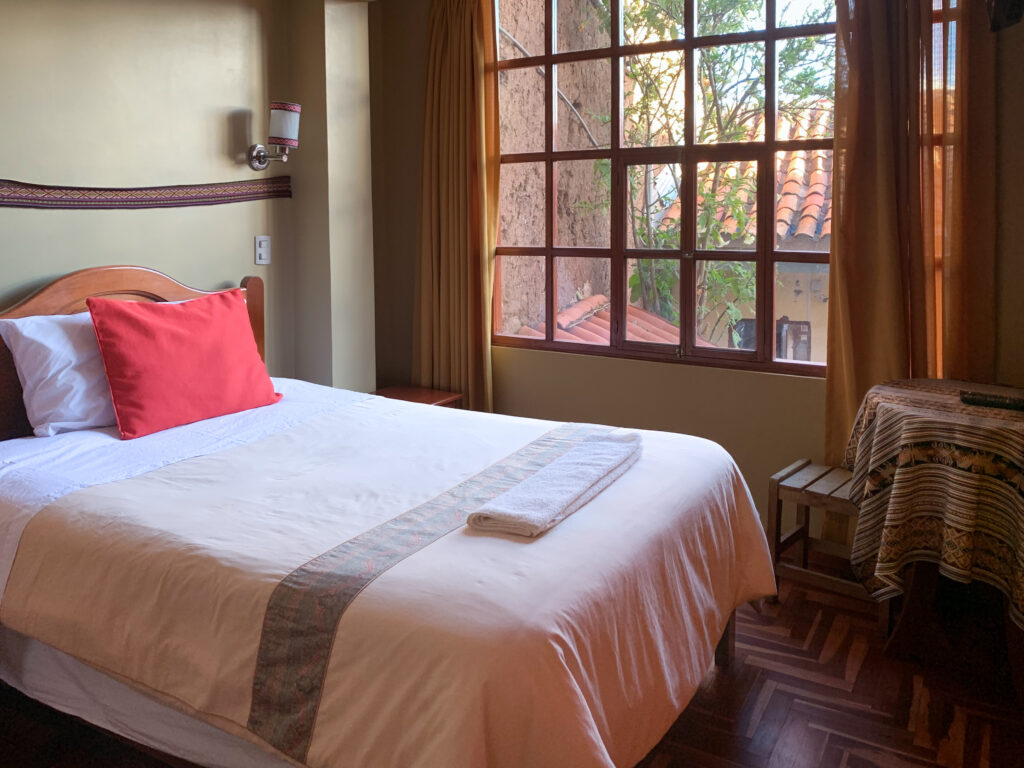
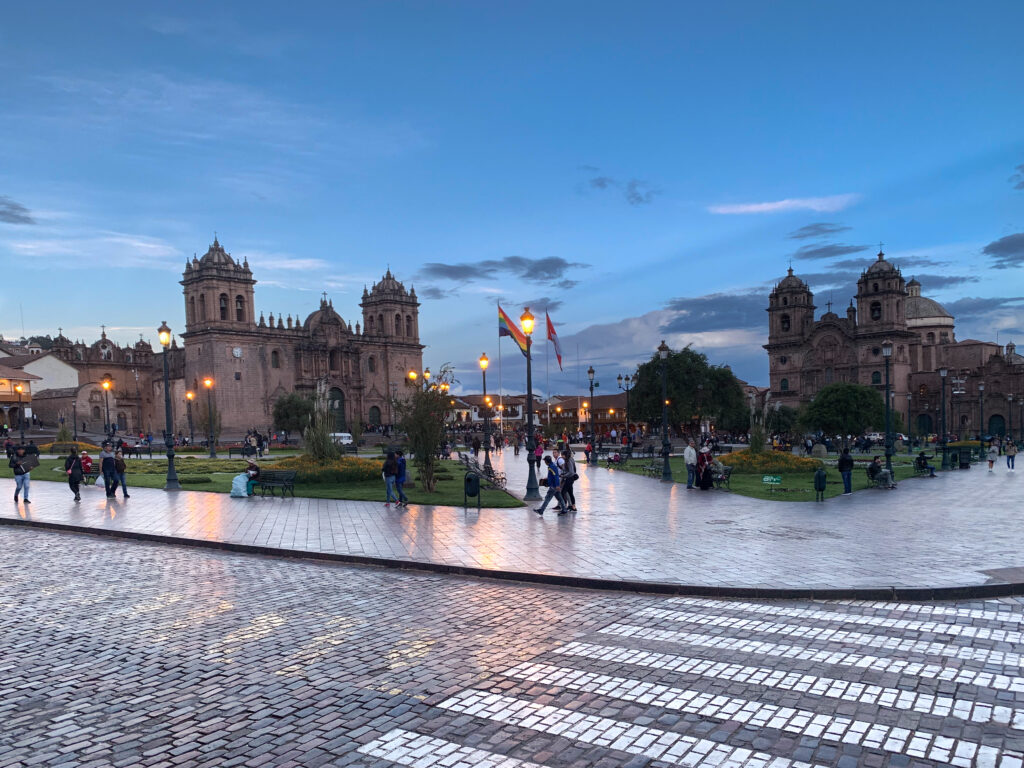
When in Cusco, Do as the Peruvians Do
With a few hours to kill before my trek meeting, I wandered toward the plaza in search of food. There were plenty of places, but most had someone posted outside trying to talk you into coming in. From experience, I’ve learned: the really good spots don’t need to beg.
I found a quiet place with a long menu of local dishes—including cuy (guinea pig), a Peruvian staple. I figured, when in Rome do as the Romans do… or in this case, do as the Peruvians. So I ordered the cuy, giant corn kernels, and a pisco sour to wash it down.
It was surprisingly good. Salty, crisp, a little gamey. Would I order it again? Maybe. But at least now I can say I tried it—like an oddly tasty rite of passage.
After lunch, I wandered through the Plaza de Armas, admiring the contrast between the colonial Spanish architecture and the massive stone walkways and walls that echoed the Incan past. Locals tried to sell me paintings, scarves, and souvenirs. I smiled and kept moving.
Heading back to my hotel for a nap, I turned into an alley when I heard footsteps rushing up behind me. I gripped my camera. Turned. Made eye contact. The runner slowed, looked at me, and passed without a word. Just a reminder—always stay alert.
Back at the hotel, I rang the buzzer. My host had my laundry ready, folded and clean. We talked briefly about my plan to return after the Inca Trail and she assured me everything would be taken care of. I liked her even more now.
The Pre-Trek Checklist and a Late-Night Adventure
Around 5:00 PM, I walked to the Llama Path office to meet my guide and the couple I’d be hiking with. The office was about a mile away—walkable, especially in Cusco where nearly everything is if you’ve got enough time and decent lungs.
There, I met the smiling porters, the guide, and the other trekkers—a couple from the U.S. on their honeymoon. We filled out paperwork, watched the introduction video on the history of the Inca Trail, and went over our itinerary. When asked if I wanted a porter to carry my gear, I politely declined. I’d carry everything myself—earning a nod of respect from our guide and, later, the other porters we met on the trail.
Afterward, I wandered further into the more local neighborhoods, eventually stumbling across what felt like a pop-up night market in the middle of the street. Then, just like that, it was gone. On the walk back to the hotel, the stalls had vanished — all that remained were a few scattered vegetable scraps and wilted leaves blowing across the pavement.
Hungry, I found a small chicken shop nestled between shuttered storefronts. No tourists. Just locals and me. The woman behind the counter gestured for me to take a seat. Not long after, a father and his kids sat down at my table. We couldn’t communicate much, but smiles and laughter didn’t need translation. For a brief moment, I felt like part of the neighborhood.
I walked back through the quiet, winding streets and crawled into bed. The alarm was set for 4:00 AM. Game time.

Day 1: Rain, Ruins, and Rolling Hills
At 4:00 AM, I pulled myself out of bed, layered up, and stepped into the cold darkness. It was raining. Of course it was. I took off a glove to check my phone map and make sure I was heading to the correct plaza for pickup — and immediately lost that glove. So here I was: wet, half-gloved, and heading off to hike the Andes. What had I signed up for?
Eventually, the van pulled up, and we were off — bumping down a winding road that followed the river like a coiled snake, passing farms, foggy hillsides, and villages just beginning to stir. After a stop for coffee, a snack, and to buy new alpaca wool gloves, we finally arrived at Kilometer 82 — the trailhead.
The sun broke through the clouds just in time for the start. Before we could begin, our porters lined up at a checkpoint scale. The Peruvian government strictly enforces how much porters can carry and requires companies to provide boots and proper gear. A far cry from the Everest experience.
We started walking. The terrain was mellow — rolling trails, open meadows, alpacas and horses grazing beside us. We passed through a small village, just a few buildings really, where you could grab a soda or snack. Chickens wandered freely. Locals strapped gear onto donkeys and headed into the hills.
Soon we came across our first set of Inca ruins — long, stone corridors framed by moss and time. Our guide explained their history while we walked through them, surrounded by quiet and the weight of centuries.
At camp, the porters had already set up our tents. Dinner was hot, rich, and well-earned. I crawled into my bag, tired but excited. Day 2 was supposed to be the hard one.
They weren’t lying.
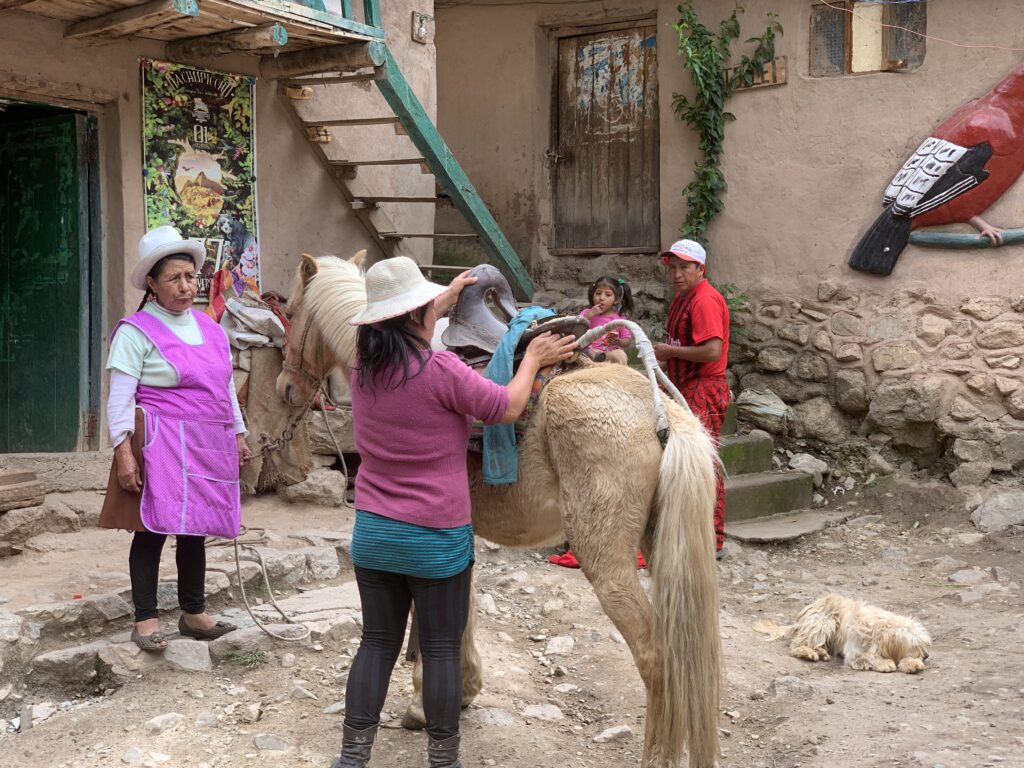
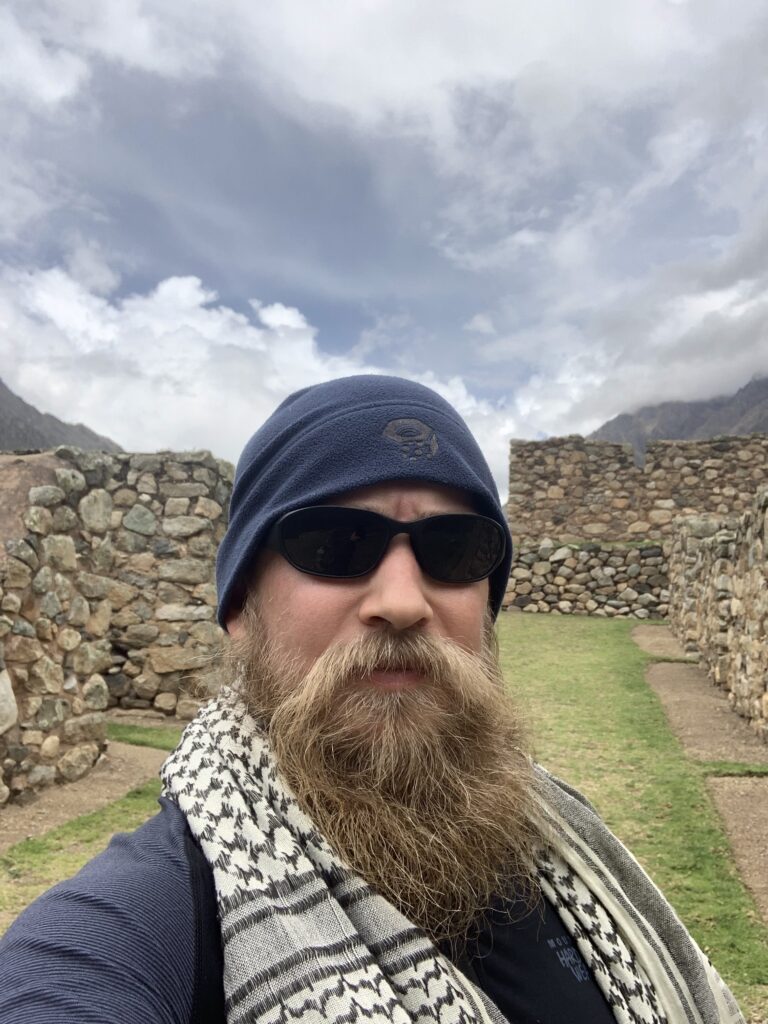
Day 2: Dead Woman’s Pass, and the Trek That Earned Its Name
Another early wake-up. Still raining. The climb began immediately — slippery rocks, mist, switchbacks that didn’t end.
This day had two passes over 13,000 feet. The first, Dead Woman’s Pass, lived up to its name. It was brutal. My boots squelched. My lungs screamed. Other groups encouraged me as they passed. I just kept repeating: One step. One more step.
At the top, I finally crested the pass, soaked and exhausted.
But the day wasn’t over.
We descended to a flat spot for lunch. But I wasn’t hungry. Nausea from the altitude had me curled up on the ground while the honeymooners enjoyed the meal. I lay still. Recharging. Quietly wondering what I’d gotten into.
Then it was time to climb again.
The second pass was shorter but steeper. The clouds wrapped us in mist. My legs wobbled. I was the last one up — carrying all my gear — but as I crested the final steps into camp, I was met with cheers.
The porters clapped. Trekking poles tapped in rhythm. I raised mine in the air, half in triumph, half in disbelief.
Dinner was another masterpiece. And then — a surprise cake. Baked somehow at altitude, in a camp kitchen, for the newlyweds. Their faces lit up. Mine did too. The chef and porters were the real heroes.
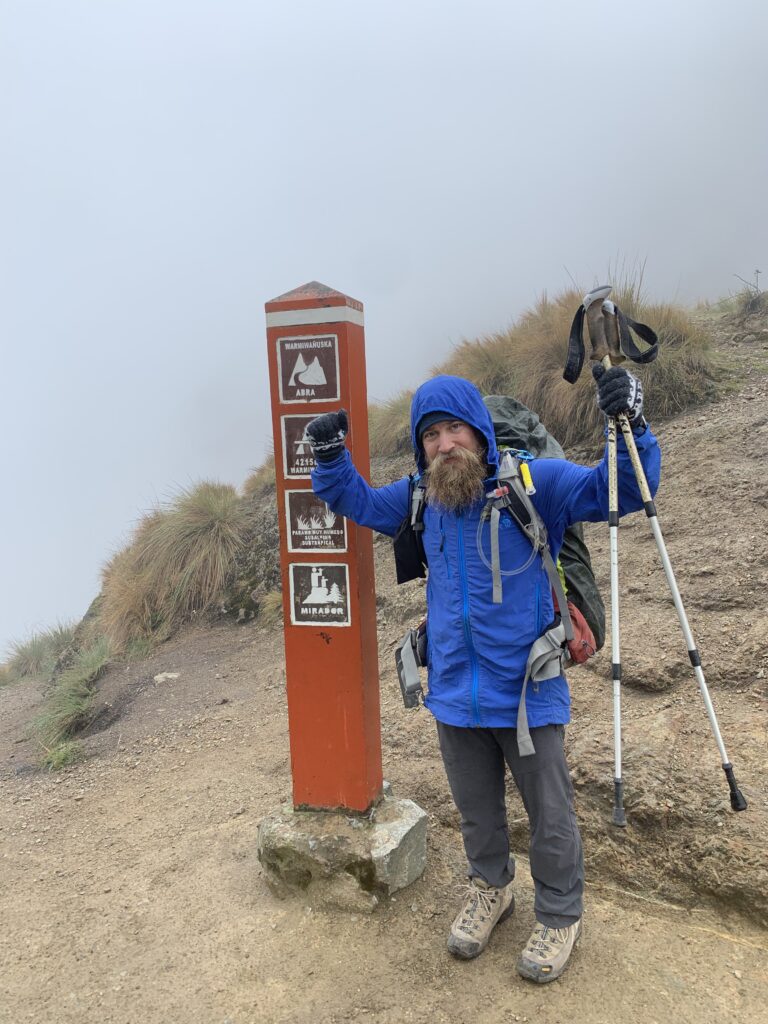
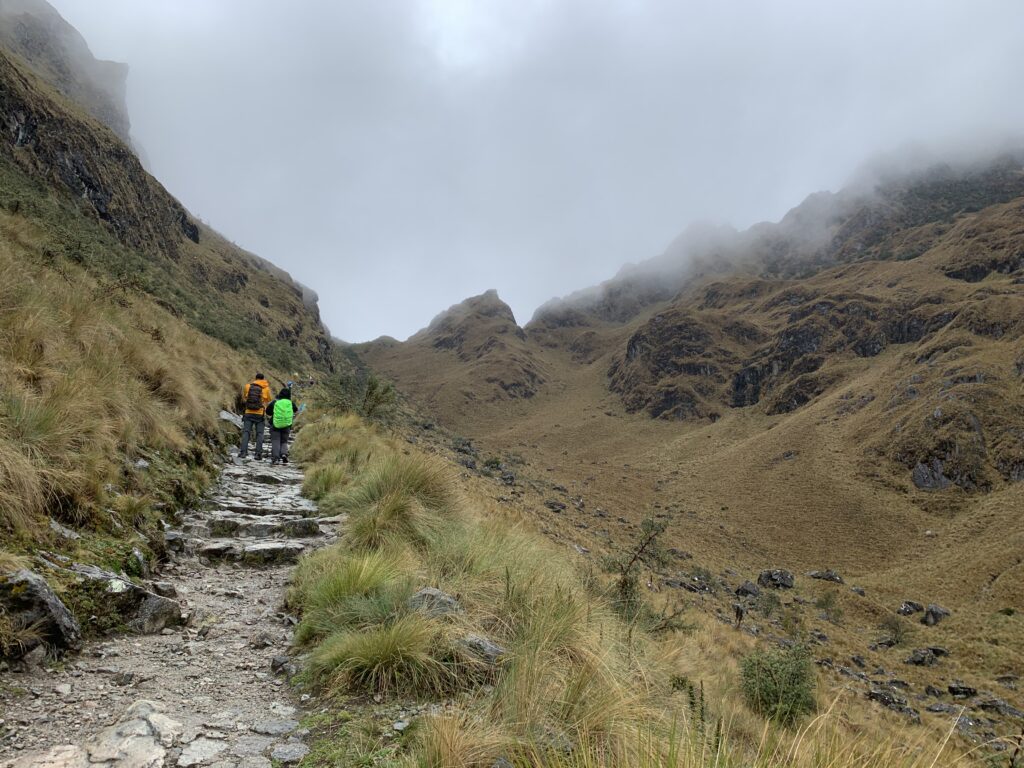
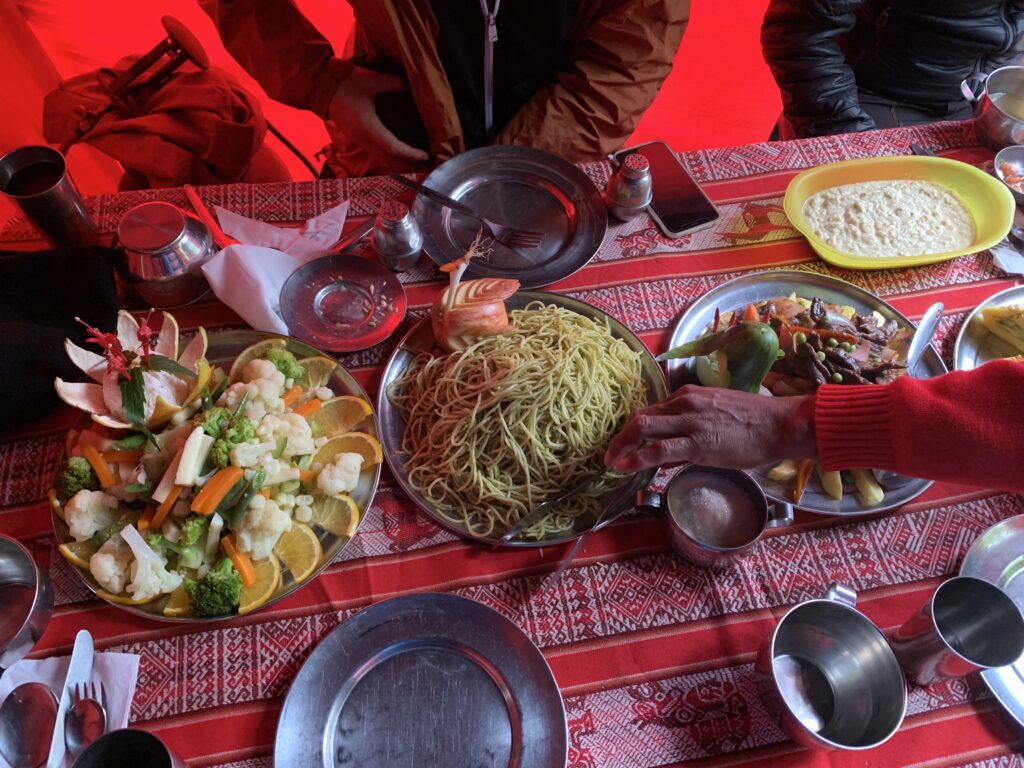
Day Three: Finding My Stride
This was the day I found my legs again.
We set out after breakfast. The couple was slower downhill, and our guide gave me the green light to go ahead. I practically ran down, flying past stone steps and rain-slicked roots. He told me to stop at a specific landmark, so I did—huddled under my poncho until they caught up what felt like hours later.
At camp, I rested in my tent while the sound of clanging pots and Peruvian music drifted in from the cook’s tent. That sound will stay with me forever.
Later, we took a short out-and-back hike to another set of ruins. Mist hung in the air. Stone staircases seemed to rise into nothingness. These weren’t just ruins—they were whispers from the past.
That night’s meal? Another full-course spread—and cookies. The chef was some kind of wizard.
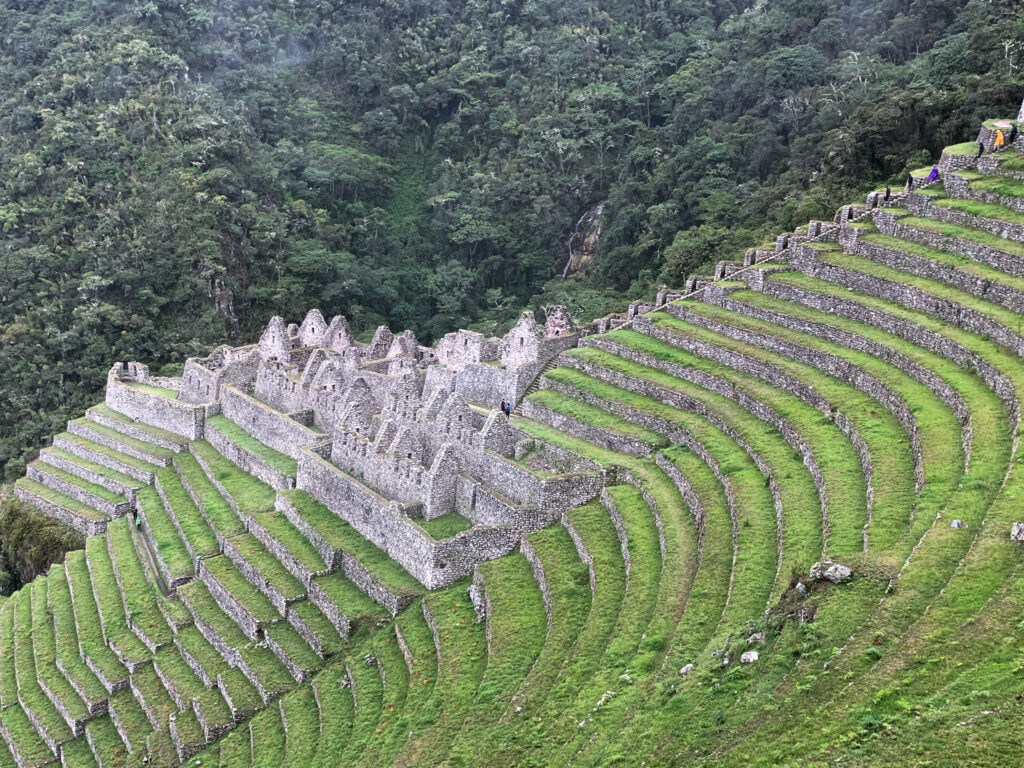

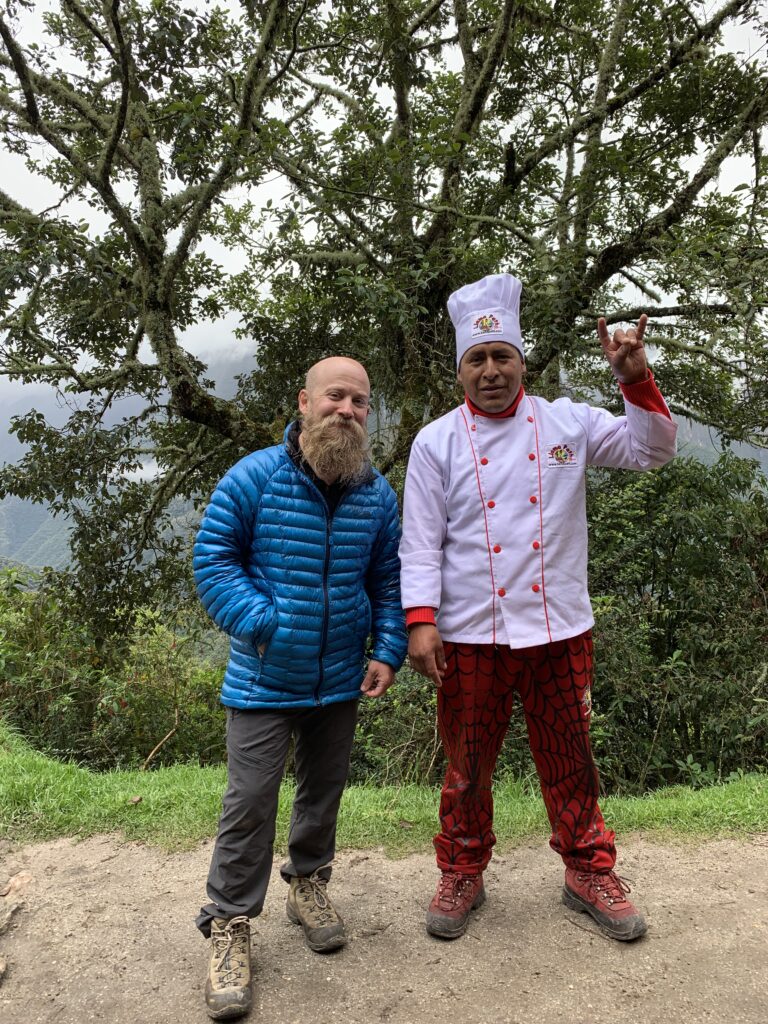
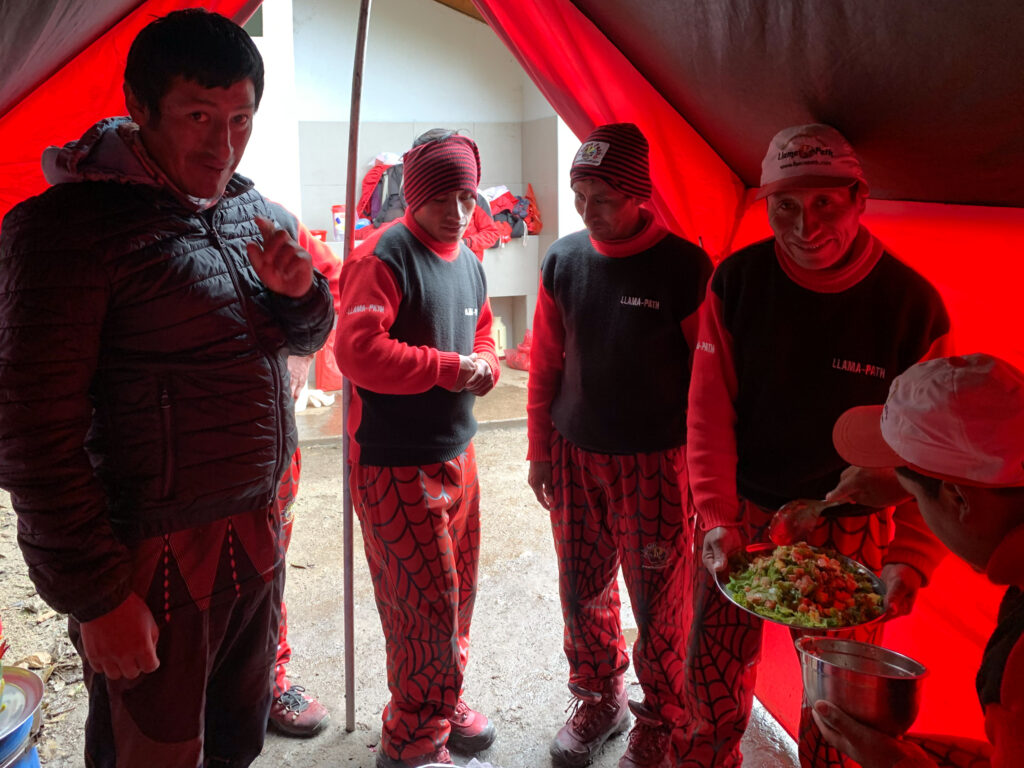
Day 4: Dark Trails and the Dash to the Sun Gate
We woke before dawn — though calling it “woke” might be generous. It was more like rolling out of a semi-conscious state and into your hiking boots. Our guide moved through the campsite like a silent drill sergeant, handing out granola bars and urgency. No breakfast. No coffee. Just, “Let’s move.”
Headlamps on, packs loaded, we hiked a short distance in silence to reach the final checkpoint before Machu Picchu. The goal? Be first in line. And we were. The gate was still locked. It was still pitch-black. And the air was cold enough to make you question life choices. Behind us, beams of other headlamps began flickering into view as the line filled with hushed voices and stiff legs.
For nearly an hour we waited, trading quiet nods and trying not to think about how sore our feet were. Then, finally, the ranger arrived. Permits checked. Gate opened.
And I took off.
Not metaphorically — literally. A borderline sprint. That final stretch of trail to the Sun Gate was no joke — steep stone stairs, slippery from rain, heart pounding, breath short. But I knew what was coming. I had to beat the buses. I had to see it first.
And then, through the break in the fog — the first glimpse of Machu Picchu.
Still empty. Still sacred. Just still, for just a moment.
Machu Picchu: Where the Trail Ends and Wonder Begins
We descended quietly, our boots brushing stone that had been laid centuries ago. The city opened up below us — terraced slopes, carved temples, and a landscape that somehow managed to be more dramatic in person than in any photo I’d ever seen.
Our guide walked us through the site like a storyteller with a favorite tale — pointing out aqueducts, sun temples, and the Compass Rock. Naturally, I tested it with my watch. Dead on. Those Incas weren’t messing around.
After the tour, we had an hour to explore solo. I wandered, slowly. I barely pulled out my camera. After everything — the climbs, the rain, the sore legs and missing glove — I just stood there, soaking it all in. The blisters faded into the background. The wonder did not.
Eventually, we boarded the shuttle bus down to Aguas Calientes — a sleepy little village wrapped around the train station. We found a restaurant and collapsed into our seats. Exhausted, hungry, and happy.
Then, in walked the encore.
A man stepped in — guitar slung over one shoulder, pan flute rigged around his neck, mic in hand. A one-man band with the timing of a magician and the heart of a poet. He played his soul out like we were in a packed stadium instead of a half-full café full of muddy boots and trail-weary faces.
We clapped. We tipped. We smiled like we had just seen something rare.
And then, the train back. Panoramic windows. Rain brushing the glass. The Andes rolling by like a slideshow of everything we’d just survived.
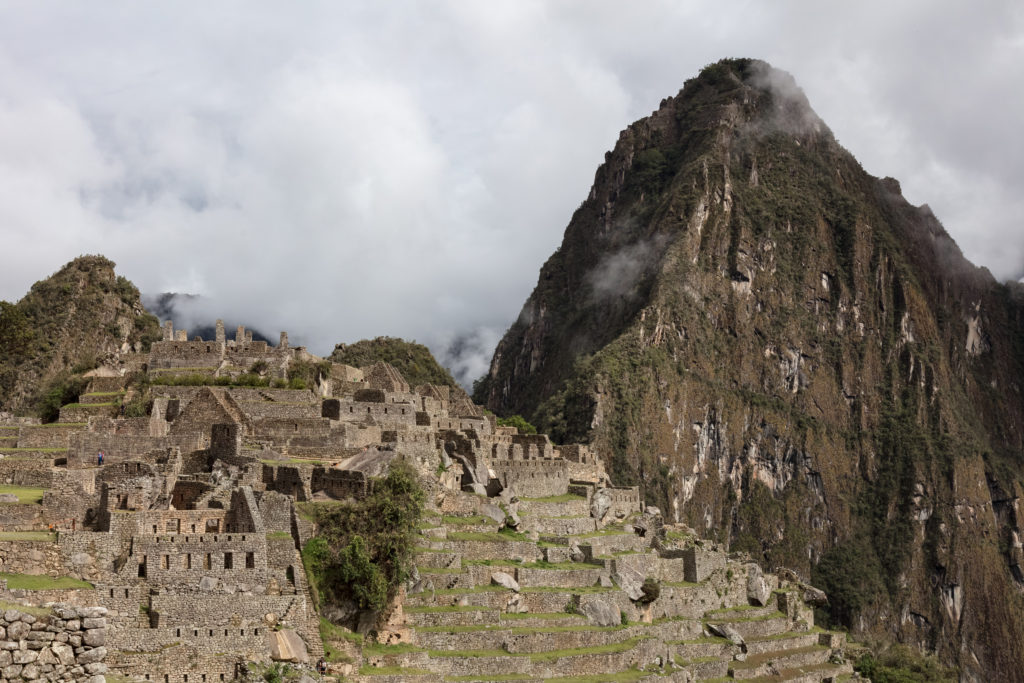
Final Night in Cusco: Streetlights, Ceviche, and a Soft Landing
Back at the hotel, my host met me with that same warm smile from the start of my trip. “How was it?” she asked.
I tried to answer, but all I could manage was a half-laugh and a nod. How do you explain something that changed you?
I was booked to hike Rainbow Mountain the next day. My legs immediately voted no. My soul quietly agreed. That adventure would have to wait.
Instead, I gave myself one last slow day in Cusco. I wandered the cobbled streets around the plaza, did some light shopping, and browsed through a local museum. No agenda. No rush. Just soft steps through stone and memory.
That evening, I found a little second-floor restaurant with a view of the Plaza de Armas. The rain had just stopped, leaving the stones below glistening under the streetlamps. I ordered a cold beer and a bowl of ceviche that nearly made me weep. Bright citrus, fresh fish, that perfect blend of sharp and soothing.
Down in the square, people laughed, danced, and passed beneath the warm glow of lanterns. Music drifted up from somewhere unseen. I just sat there — watching, listening, breathing.
No more miles to walk. No more passes to climb. Just the hum of a city older than memory and the peace of knowing I had carried my own wonder all the way to the end.
It was the perfect closing chapter.
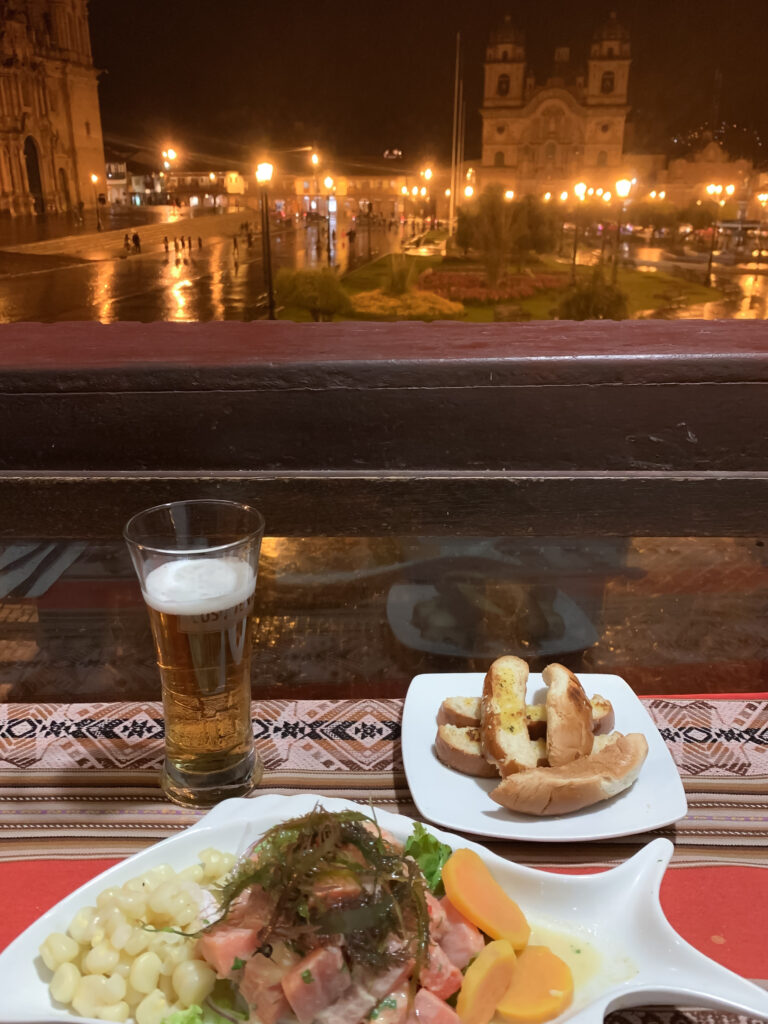
One Step at a Time
If this made you want to hike the Andes, carry your own pack, or just remind yourself what you’re capable of — share it. Or better yet, book your own trail and see what rises up in you.
Because sometimes, the only way to feel the wonder… is to carry it.
I’ll be back next Tuesday with more from behind the lens — same mission: find the wonder, frame the chaos, and tell it straight.
— Brice
